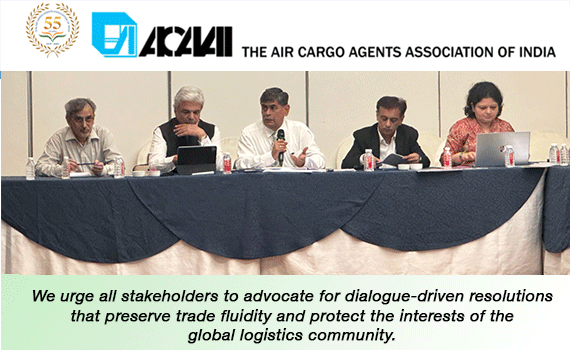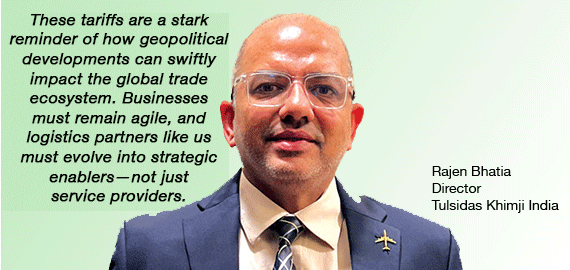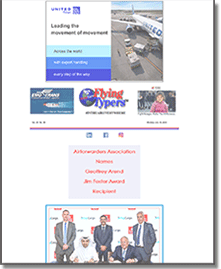Breaking News—India's air cargo sector is preparing for significant challenges as U.S. President Donald Trump shocks global markets with a steep 50% tariff on Indian exports. |
This move has sent shockwaves through India’s logistics and export communities, risking the unraveling of recent trade gains driven by diversification and closer U.S. relations.
The Air Cargo Agents Association of India (ACAAI) has raised alarms, describing the development as “a significant disruptor to global trade stability.” In a strongly worded statement, ACAAI warned that such tariff hikes “impact cost structures, routing strategies, and supply chain confidence,” especially for freight forwarders and air logistics firms already operating on thin margins amid geopolitical uncertainties.
“India’s EXIM community has built momentum around diversification and trade expansion with the U.S., and sudden tariff escalations risk undermining these gains,” ACAAI emphasized.
 |
 Dinesh K. Krishnan, (left) who has over 30 years of experience in logistics and is the Founder and Managing Director of United Shipping Services (notably the first Indian freight forwarder to establish an independent branch in Antwerp Port, Belgium, in 2004), shared his insights. “As of now, there is no panic among cargo stakeholders, but we will definitely see a drop in tonnage to the U.S. sector if the 50% tariffs continue,” he said. He expressed concern that American consumers will face higher costs for Indian goods and that American companies manufacturing in India for the U.S. and global markets will be significantly impacted. “But till then, the nation will have to endure stress,” he added. Dinesh K. Krishnan, (left) who has over 30 years of experience in logistics and is the Founder and Managing Director of United Shipping Services (notably the first Indian freight forwarder to establish an independent branch in Antwerp Port, Belgium, in 2004), shared his insights. “As of now, there is no panic among cargo stakeholders, but we will definitely see a drop in tonnage to the U.S. sector if the 50% tariffs continue,” he said. He expressed concern that American consumers will face higher costs for Indian goods and that American companies manufacturing in India for the U.S. and global markets will be significantly impacted. “But till then, the nation will have to endure stress,” he added.
Another veteran forwarder, Rajen Bhatia of Tulsidas Khimji Pvt. Ltd (TKPL), a 130-year-old logistics and supply chain company based in Mumbai, highlighted that the tariffs have undoubtedly sparked concern within India's business and logistics circles. “From our perspective, the new tariffs are likely to create immediate headwinds for Indian exporters, particularly in key sectors like engineering goods, textiles, and automotive components—all of which depend heavily on the U.S. market,” Bhatia noted.
He anticipated immediate disruptions in outbound volumes, especially in air and sea freight, as exporters reassess pricing and order commitments. Clients are reportedly approaching logistics providers for contingency planning—including shipment rescheduling, inventory repositioning, and rerouting through alternative markets. Bhatia also mentioned expectations of a short-term spike in regulatory clarifications, customs complexities, and compliance advisory needs—particularly if sector-specific tariff bands are introduced. “The pressure will be on both exporters and logistics players to stay adaptive and informed,” he stressed.
 |
Despite these tensions, ACAAI remains hopeful. “We urge all stakeholders to advocate for dialogue-driven resolutions that preserve trade fluidity and protect the interests of the global logistics community,” the association stated.
Amid this protectionist shift, industry voices are emphasizing the importance of self-reliance. ACAAI pointed to the Atmanirbhar Bharat mission as an urgent initiative to bolster domestic manufacturing and diversify markets—especially in electronics, defense, and energy sectors that are heavily reliant on air cargo movements.
Bhatia expressed optimism, stating that “India’s growing competitiveness and resilience offer a silver lining. We believe this development will accelerate efforts towards greater value addition, diversification of export baskets, and increased intra-Asia trade—where India is well-positioned to take a leadership role.” He further highlighted that logistics partners will need to shift towards strategic enablers, providing tariff impact advice, cost modeling, and agile fulfillment options such as bonded warehousing or FTWZ (Free Trade Warehousing Zones) utilization.
“These tariffs,” he concluded, “are a stark reminder of how geopolitical developments can swiftly impact the global trade ecosystem. Businesses must remain agile, and logistics partners like us must evolve into strategic enablers—not just service providers.”
 The industries most immediately affected are pharmaceuticals, apparel, and gem & jewelry—sectors where air cargo is the primary export channel and the U.S. is a dominant market. Tushar Jani, (right) Chairman of Cargo Service Centre, described the tariffs as “pressure tactics,” linking them to disputes over genetically modified seeds and e-commerce access. He cautioned that the pharmaceutical sector could feel the sharpest impact: “Most impacted will be pharma on both sides. 31% of generic pharma for the U.S. comes from India. Whoever gives in first will decide the deal.” The industries most immediately affected are pharmaceuticals, apparel, and gem & jewelry—sectors where air cargo is the primary export channel and the U.S. is a dominant market. Tushar Jani, (right) Chairman of Cargo Service Centre, described the tariffs as “pressure tactics,” linking them to disputes over genetically modified seeds and e-commerce access. He cautioned that the pharmaceutical sector could feel the sharpest impact: “Most impacted will be pharma on both sides. 31% of generic pharma for the U.S. comes from India. Whoever gives in first will decide the deal.”
 Namit Joshi, (left) Chairman of Pharmexcil, underscored the potential catastrophe: “India supplies nearly 47% of the U.S.'s generic drug market, including critical cancer and chronic disease treatments. Any disruption to this supply chain will inevitably lead to shortages and rising prices. The long-term impact could be catastrophic. It would take the U.S. 3–5 years to establish meaningful domestic capacity to replace Indian suppliers.” Namit Joshi, (left) Chairman of Pharmexcil, underscored the potential catastrophe: “India supplies nearly 47% of the U.S.'s generic drug market, including critical cancer and chronic disease treatments. Any disruption to this supply chain will inevitably lead to shortages and rising prices. The long-term impact could be catastrophic. It would take the U.S. 3–5 years to establish meaningful domestic capacity to replace Indian suppliers.”
 The gem and jewelry industry, which exports over $10 billion worth to the U.S., faces immediate and severe threats. Kirit Bhansali, (right) Chairman of the Gem & Jewellery Export Promotion Council (GJEPC), explained that a 25% tariff inflates costs, distorts pricing, and “puts immense pressure on every part of our value chain—from small karigars (skilled artisans) to large manufacturers.” The threat of halted exports and threatened livelihoods has cast a shadow over the sector. The gem and jewelry industry, which exports over $10 billion worth to the U.S., faces immediate and severe threats. Kirit Bhansali, (right) Chairman of the Gem & Jewellery Export Promotion Council (GJEPC), explained that a 25% tariff inflates costs, distorts pricing, and “puts immense pressure on every part of our value chain—from small karigars (skilled artisans) to large manufacturers.” The threat of halted exports and threatened livelihoods has cast a shadow over the sector.
 India’s apparel exporters, while cautious, remain hopeful. Thiru Kumaran, General Secretary of the Tirupur Exporters Association, noted that “India still holds a relative advantage over competitors like Bangladesh and Cambodia, who face even higher U.S. tariffs. We’re at a disadvantage with Vietnam but remain optimistic. Both governments will likely negotiate a fair deal. The impact should be short-term, and there’s no need to panic,” he said. India’s apparel exporters, while cautious, remain hopeful. Thiru Kumaran, General Secretary of the Tirupur Exporters Association, noted that “India still holds a relative advantage over competitors like Bangladesh and Cambodia, who face even higher U.S. tariffs. We’re at a disadvantage with Vietnam but remain optimistic. Both governments will likely negotiate a fair deal. The impact should be short-term, and there’s no need to panic,” he said.
 Rahul Mehta, Chief Mentor of the Clothing Manufacturers Association of India (CMAI), urged calm amidst the uncertainty: “Our exports will become 7% to 10% more expensive, but with recent FTAs with the U.K. and ongoing talks with the EU, we are not without options. It’s a tough time, but not beyond our capacity to handle,” he was quoted saying. Rahul Mehta, Chief Mentor of the Clothing Manufacturers Association of India (CMAI), urged calm amidst the uncertainty: “Our exports will become 7% to 10% more expensive, but with recent FTAs with the U.K. and ongoing talks with the EU, we are not without options. It’s a tough time, but not beyond our capacity to handle,” he was quoted saying.
Looking ahead, India’s air cargo volumes to the U.S. could see sharp declines if tariffs persist. Perishable shipments like pharmaceuticals and high-value goods such as gems depend on speed-to-market, and increased duties could shift demand away from Indian suppliers. Nonetheless, India’s established fast-turnaround air freight capabilities, coupled with ongoing logistics constraints worldwide, may help maintain some competitiveness—if clarity on policies and pricing is achieved swiftly.
For now, the message from India’s air cargo sector is clear: the U.S. tariff escalation is a challenge, but also a pivotal moment for India to intensify reforms, build resilience, and pursue robust multilateral trade diplomacy. As ACAAI concluded, “A self-reliant India is not about isolation. It is about innovation, resilience, and global integration on India’s terms.”
Tirthankar Ghosh
|





 Vol. 24 No. 35
Vol. 24 No. 35